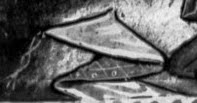While I was browsing the rather lushly illustrated in the last post, I noticed lots of features not related to women's costume. Several of them are ones I haven't seen in visual sources before.
Remember, the manuscript was Periscope book of St Erentrud, Nonberg Abbey, Salzburg around 1140 (München, Bayerische Staatsbibliothek, Cod. lat. 15903)
Fol . 68 Healing of the sick
That holy grail of pictures, a depiction of hose gartered at the knee. Not you can see what we know from extant examples. The extant examples have their garters sewn to the back of the hose at the top (eg Roger's pair - but you can't see that in this photo). The pair I've made so far I use a separate piece of cord and fold the top of the hose over. It works quite nicely, but I'll have to try the other way with my next pair.
The depiction is of gartered long hose, or at least it shows no tops of the hose, so I presume these are separate garters of necessity.
Their are lots of depictions of people wearing hose in most manuscripts, but most don't give many clues to their construction. There are quite a few pairs of hose depicted in this manuscript that have diagonal stripes checks or diamond patterns. [1] , [2], [3], are just a few examples. These may be indications of the cut of the hose - extant hose are known to be generally bias cut (the later ones are definitely so, I don't have any info on 12th C ones), such that the hose are slightly stretchy. Plain woven stripes and checks become diagonal stripes and checks when cut on the bias. I think this tendency to show diagonal patterns on hose (which I've also seen on other artwork) represents this. This manuscript also contains the first example I've seen contrary to the rule - a pair of hose with horizontal stripes. Mind you, I think only a couple of stripes is unlikely to be a woven in pattern, so this could represent post-construction decoration. Or just an artist on a funny day.
Just for variety, there is also one pair with trios of dots on them.
folio 11v stoning of st Stephen
This site says stoners "were laying down their garments at the feet of Saul, that they might be more ready for the task devolved upon them" so the object should be clothing, unspecified variety. They look like hose to me, but I see no reason why they should remove only their hose and not their other garments. The feet of the hose are not visible, making this identification uncertain, but the string at the top point of this pair is just what we expect from 14th C hose. The pattern on the reverse side reminds me of the buskins of archbishop Walter Hubert (c1200), pictured on right. I presume showing one side patterned and the other not is artistic license for showing the folds more clearly.
Fol 93, Martin divides his cloak with a beggar
This pilgrim/beggar (the caption and story say beggar, his bag and staff say pilgrim) looks like he might be wearing sandals. I've seen biblical figures with thonging around their feet, but they might just be romanticising the past. A pilgrim might wear rather humble footwear than average, so this might be realism. The drawing of his legs makes him look barelegged.
If you look at the object around his shoulders, you'll see an object that sits above his tunic. Quite a few other guys have these , but on the others you couldn't tell if it was part of the tunic (although in several cases it was a different colour) for example the trim or neck facing. This example clearly shows the object on top of the trim on the tunic. I can think of few objects that are wrapped around necks other than hoods and scarfs (and it looks to structured for a scarf). This is quite different (shorter) from any other 12th C hoods I've seen, but compare it to this 13th C hood (caption on this post), which is quite tight on the neck and doesn't extend far down the torso. I think it's a hood, but I can't prove it conclusively, since not one of the following examples from this manuscript wears one over his head: [1], [2], [3], [4], [5], [6], [7], [8], [9].
Fol 93, Martin divides his cloak with a beggar
The pilgrim has a nice example of pilgrim satchel in fairly typical shape (rectangular or square with a flap, and pilgrimage symbol eg cross or shell) and size (look how small they are!).
This is another scene I've seen a few times (caption on this post)- poorer male travellers carrying their goods over a stick. The goods appear to be contained in some kind of saddlebag or roll. I've heard of a later period bag style where you make a roll like a long pillowcase, sew the ends closed and create a slit across the width of one side only of the middle. I think this has a similar construction, but not being a rich man's object we are unlikely to find out.
Tuesday, 23 January 2007
Costume acessories from Cod. lat. 15903 Bayerische Staatsbibliothek
comming live to you at
2:25 am
Labels: 12thC austrian manuscripts, 12thC germanic dress, acessories, bags, clothing, dress, garters, hoods, hose
Subscribe to:
Post Comments (Atom)


1 comment:
You might be pleased to know, when looking for bias-cut patterned hose, your blog was the first hit on google. Congratulations! =)
~Asfridhr
Post a Comment